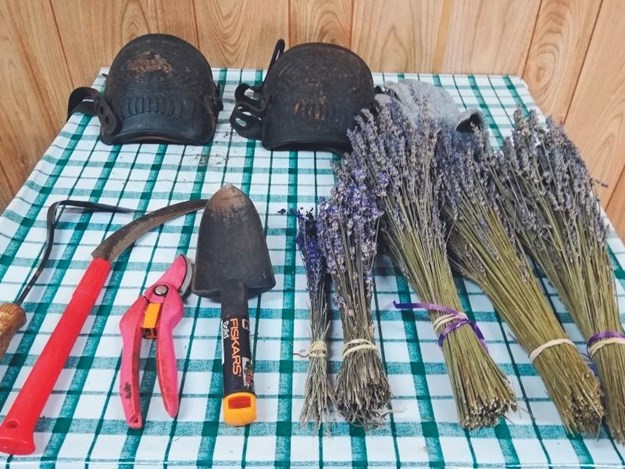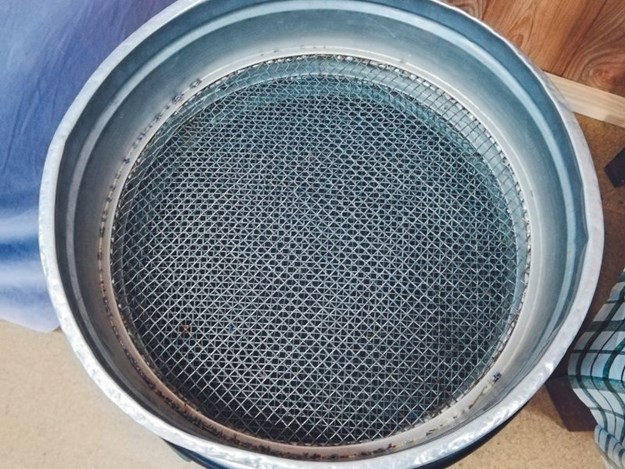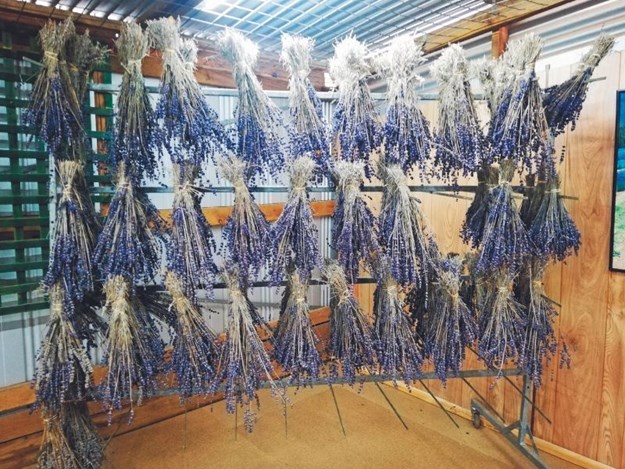It's a mainstay of many a country garden, but lavender has become a winning crop for growers all around Australia - with bunches of potential. Lincoln Bertelli meets some of the industry's leading growers.
.jpg) |
|
Annemarie Manders works among the lavender at Warratina Lavender Firm
|
Floral and fragrant. Humble and hardy. Purple and popular. The lavender plant may not immediately be front of mind when thinking about Australia’s agricultural industry, but its growing history in this country goes back more than a century and it could very well be about to boom.
Last year, a partnership was signed between AgriFutures Australia and LaTrobe University for a research project into lavender growing and creating a detailed knowledge base of the ideal conditions and farming methods for every stage of the process.
Funding for this was received through AgriFutures’ Emerging Industries Program, which identified lavender as a rural industry capable of reaching or exceeding $10 million in revenue by 2022.
The Australian Lavender Growers Association (TALGA) is a partner in the project, with plans for its members to have full access to the completed database.
TALGA is thriving, with secretary and Victorian lavender grower Fiona Glover estimating that the association’s membership has grown by between 10 and 15 per cent this year.
“We’ve had quite a number of new members across Australia this year, so I can certainly say there is a big interest in growing lavender in Australia,” she says.
“I’m not quite sure what drove it. First of all I thought [it was] because lavender is a hardy crop and people with lots of land are thinking of what they can grow if they don’t have much water, which was certainly an issue last year.
“This year it’s almost like it’s a favourite because it looks nice, smells nice, people can get oil from it, so maybe it’s not so much the dry gardening aspect but because it’s a multi-purpose crop.”
TALGA’s website has 32 lavender farms across Australia listed in its directory and the association’s annual general meeting and conference, which was held in South Australia during May, attracted around 70 people.
Glover says this was a mix of core members, those who had just started and “wanted to check whether they were on the right path” and non-members interested in meeting experienced growers before committing to planting lavender.
 |
|
Some of the equipment used for lavender harvesting at Warratina, including a sickle
|
ORIGIN STORY
TALGA’s story begins in the 1990s but lavender growing in Australia dates back more than a century prior to that.
Lavender has been grown in Australia since the late 19th century, Glover explains, and one TALGA member – Bridestowe Lavender Estate in northern Tasmania – celebrates its centenary in 2021, albeit with a history that involves changes of ownership and not being open continually to the public.
TALGA was the brainchild of the late Rosemary Holmes, who had farmed lavender near Ballarat since the 1980s and noticed increasing interest from potential growers about a decade later.
“It was very difficult to find lavender plants to even buy to plant,” Glover explains.
“She did open to the public and kept getting people asking her how to grow lavender and felt there was a need for an association.
“She set it up formally in 1995 and based it on visitor books she had, so she rang those people and a lot of them joined.
“Many have gone, perhaps they were only hobby gardeners, but that’s how it started and we’ve just kept going ever since.
“We are a community of lavender growers and we do help each other; that’s the point of it, even if it’s just to sell something.
“It works as a community organisation. You can contact someone and ask ‘do you want this?’ so I think there are more benefits in belonging than not belonging.
“We always get that natural attrition but it’s nice to see young people as well, perhaps late 30s or 40s, who are keen to get into it, make products and get out there.”
.jpg) |
|
The earlier years at Warratina Lavender Farm
|
WANDERING IN WANDIN
Less than an hour from Melbourne but feeling a world away, Warratina Lavender Farm is an impressive destination.
Located at Wandin in Victoria’s Yarra Valley, it is the evolution of nearly three decades’ work by Annemarie Manders, an energetic and passionate former operating theatre nurse who admits the farm was only ever meant to be a hobby.
“I knew nothing about soil nutrition or that you needed to do it, how you grew your lavender, what it needed, what kind of soil, how you would harvest it – I absolutely knew nothing but I jumped in the deep end,” she says.
“Two years later I decided it was fantastic. I’d learned how to drive the tractor and learned a bit about weed control – but I’m still learning 29 years later and I decided to make this into a business.
“I had no idea about staff, running a business [or] regulations and I can honestly say, if I knew then what I knew now, and if I had to do then what I had to do now, I wouldn’t have started.”
 |
|
Lavender is sifted through three grades of sieves after being stripped
|
However, plenty of people are thankful Manders did.
From humble beginnings, where the absence of infrastructure meant Manders’ office was in the laundry and lavender had to be dried wherever space could be found around the house, Warratina now boasts a tea room and café, retail shop, private gardens and necessary additions for a tourist business such as seating, a car park and road signage.
Manders’ business-savvy mind has also meant Warratina does plenty to bring people to the farm all year.
“You want people to have an experience and enjoy their time here,” she says.
“I have a motto – give people a reason to come, give them a reason to linger and give them a reason to come back.
“We want to give people another reason to visit the farm so, in the winter time when the lavender isn’t flowering but we don’t want to close, what do we do?
“We’ve got an empty drying shed, so for 20 years I have run exhibitions in there.
“You need to have a passion, an amazing amount of energy and you need to understand that you won’t always make a lot of money but it’s about the experience.”
Warratina hosts a patchwork quilt exhibition that has run for 20 years, a woodworking expo with 15 years of history, private exhibitions, markets and even an Easter egg hunt.
A mini-market in January celebrating Yarra Valley produce was the first major event at the farm after the COVID-19 pandemic meant Victoria went into extended lockdown last year and this attracted about 750 people across two days.
Naturally, though, the farm truly comes to life during harvest season.
“Our big event for the year is our lavender harvest, but we’re just calling it the Lavender Festival and it’s at the very beginning of the lavender season,” says Manders.
“You can’t determine exactly when the lavender is going to be ready – one year it will be two weeks earlier and the next it will be two weeks later.”
Normally taking place in November – and scheduled for the third weekend of that month in 2021 – the farm is at its most picturesque during harvest season and crowds pay an entry fee to visit Warratina, which also includes a small tub of lavender ice cream and a talk held in the drying shed.
.jpg) |
|
The shop at Warratina sells a wide range of lavender products, both culinary and non-culinary
|
ON THE TOOLS
While the vast majority of Australian farms across all agricultural sectors are not tourist attractions like their lavender counterparts, they do have the obvious things in common – they use machinery and equipment and create products to be sold.
One unique aspect of lavender farming is much of the work is still done by hand.
Manders grows both culinary and non-culinary lavender with two of the varieties – Munstead and Egerton Blue – being used in food.
“All lavenders have a degree of natural camphor in them but culinary lavenders have very little camphor in them, which is toxic to your stomach, and that’s why you can use them in food,” she explains.
“They flower first in the lavender season, which starts in November depending on where you are located.
“In our case, we start picking the Munstead and Egerton Blue at the end of November.
“If you were in Tasmania it would be the end of December; they’re pretty much a whole month later.”
Climate makes a difference and, according to Glover, a Mediterranean-style climate is best.
“At TALGA, I do get enquiries from people in Queensland where they have got tropical weather and high humidity – lavender does not like those conditions,” she says.
“Lavender likes a dry climate, fairly hot summer and loves altitude, so plants really thrive better when you’re at least 300m above sea level.
“You really need to wait two or three years to get a mature plant and keep it looking nice if you want tourists, do some landscaping and perhaps plant companion plants as well like rosemary, which is a herb [and] Mediterranean climate-type like lavender.”
 |
|
The lavender is hung to dry in the drying shed for around two weeks
|
While many people may have seen a lavender bush growing and simply picked a sprig off at some point in their life, the process of farming it for sale is much more complex than that. Manders takes up the story.
“All our lavender is picked by hand with a sickle,” she says.
“We bring all the bunches up to the drying shed and hang them upside down to dry. They take about two weeks to dry. After that time and when they’re dry and you’ve got the right atmospheric conditions, which is very little humidity, you can then strip it.
“We used to strip it by hand but now I’ve got a machine, but it still means you need somebody to stand at the machine with a bunch in each hand so you can do two bunches at a time.
“The brush rubs the dried lavender heads off and then they fall through a chute into a big bin.
“When it’s all stripped we still have to sift it and we do that through three grades of sieves – gross, medium and fine.
“The lavender falls through the first two but not the bottom one but the flower dust does and that’s how you get your nice clean lavender free of sticks and leaf.
“We then pack it into bags and weigh it out at 5kg a bag and put it into a box, then we freeze it for eight to 10 days at -18 degrees C. What that does is kill any potential bugs or insects and then we put a label on it to say it has been cold treated so it has not been fumigated.
“A whole month after we’ve picked the Egerton Blue and the Munstead, the other variety we grow then flowers, which is the one you use in craft work, little bags like heat packs and sleep pillows.
“We’ve got a month between the first harvest and the second, which was more good luck than good management.
“We get the shed empty with the first lot – the culinary lot – and that gives us room for the second lot and then we haven’t got pressure on us to get the second lot stripped.”
.jpg) |
|
Located in Victoria’s Yarra Valley, Warratina is open evene when the lavender is not being harvested
|
SECRETS TO SUCCESS
The shop at Warratina Lavender Farm carries a wide range of products, including the obvious options like dried bunches but also many which may not immediately spring to mind, showing the versatility of lavender.
“There has been a huge increase in interest in culinary products,” Manders says.
“People are much more adventurous now in trying new things.
“They love the tea, they love the honey, strawberry jam is really popular, mustard is also popular. We also sell shampoo and conditioner, massage oil [and] essential oil.
“There has been such a demand for the lavender that we are barely going to have enough for ourselves to get us through the year.
“We had huge demand for dried bunches in February with Valentine’s Day and had to take dried bunches off our website – we will run out of those for sure.”
.jpg) |
|
Bridestowe Lavender Estate in Tasmania is a TALGA member and has a century of history
|
While diversifying the product range helps to make more money, both Manders – who is an active member of TALGA and did a presentation on marketing and adapting to change at this year’s conference – and Glover agree that opening to agritourism will give potential lavender farmers the best chance of success.
“Going back to that original motto – you need to have a passion, you need to have energy,” Manders says.
“People grow lavender for different reasons – they might just grow for essential oil, and a lot of growers are doing that, and they don’t want to be open to the public.”
Glover believes combining product sales and tourist dollars should be the aim for new farmers.
“Tourism is the way people come to you and spend money, not just on your lavender but also cups of tea and coffee and whatever else you can offer,” she says.
“It takes away from that seasonality, and if you’re clever you can plant lavender that flowers in winter so there is still something pretty to look at.”
.jpg) |
|
The fields at Hahndorf Lavender Estate in South Australia, which was visited by TALGA conference atendees this year
|

